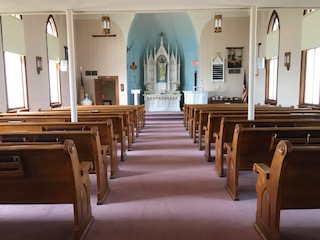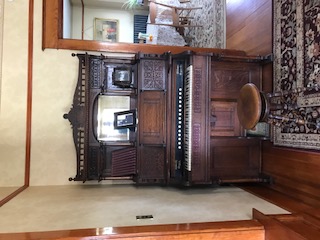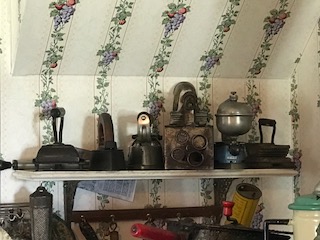Living the Good Life with the Corn Huskers
- Nathan and Lori
- Oct 2, 2017
- 9 min read
“I would rather be on my farm, than be emperor of the world”
George Washington
State 15: Nebraska - September 7, 2017
Nate

We woke up at a Walmart in York, NE excited about today's event! We headed back across town to visit the Cross Country Couple's “Made in the USA Factory Tour”, for the state of Nebraska, but this time with a twist. Instead of choosing a factory to tour, we are off to Wessels Living History Farm to meet our gracious hosts John and Hillary to experience a day in the life on a 1920’s Nebraska farm. We are going to hand pick and shuck corn, feed the livestock, hand pump water from a well, learn about tractors, make kettle corn in a cast iron pan over a wood fire stove, and so much more. Lori and I know very little about farming and agriculture, so this should be extremely enlightening. So put on your overalls, grab your pitch forks, fire up that tractor, and give us a hearty HEE HAW, because we are off to experience farm life Nebraska style!

Wessels Living History Farm is the actualization of the dream of man named David Wessels to preserve the simple life of a Nebraska farmer. David was one of six children in the Wessels family whom lived and worked on their York, Nebraska farm. After his parents retired in 1946, David and his brothers carried on their legacy of hard work and commitment. David Wessels was remembered as a man who was a straight shooter, a hard worker, honest above-board, a family man, having a heart of gold, and was proud of his heritage as a Nebraska farmer. People were very important to Wessels, and he always was enthused to share the farm with others. Upon Wessels passing in 1993, he did not take his dedication to rural America to his grave, and his will proclaimed, “a certain amount of land and capital should be set aside to establish the Wessels Living History Farm”. With those few simple phrases, Wessels bestowed upon the world the opportunity to share the story about the importance of American agriculture, and the enduring spirit of the American farmer.
While Wessels idea was admirable and ingenious, a bigger problem soon emerged. What exactly is a “Living History Farm”? In 1995, The York Community Foundation, formed a committee tasked with carrying out Wessels vision. After five years of research, the definition of a Living History Farm began to take shape. The site would consider the past, present, and future of farming. Not only would there be an actual farm located in York, but it would also be shared digitally over the Internet to reach millions more. The physical site brings to life the history of agriculture for local visitors, and the website spreads that message to the world. York Community Foundation filed suit to establish the legal definition, and with that action “Wessels Living History Farm.” became a reality!
With the plans approved, construction of the website began highlighting the history of farming from the 1920’s through present day. Concurrently, development of the physical 145 acre farm site began. All of the structures on the Wessels Living History Farm were moved there from off-site locations. The buildings currently on the site include the actual early 20th century farm house where David Wessels once lived. A video of the house actually being moved to the farm is on their website, and it is quite the nail biter! Other buildings relocated to the physical farm site include: a barn, grainary, machine shed, garage, chicken coop, large windmill, a late 19th century schoolhouse and 1905 church, which was moved from the town of Thayer which was 17 miles away. The physical farm also includes a modern building featuring 20 restored tractors, stationary engines and a combine that belonged to Dave Wessels.
The most impressive part of Wessels Living History Farm is it's a real working farm, and chores need to be completed each day. Won’t you help us cook with the wood stove, churn the butter, tinker with antique tractors, harvest oats, feed the animals, shuck corn, hand pump water from the well, and gather eggs? While you are at it, can you please pick the tomatoes, which are overflowing from the garden? When you are finished with all of your chores, come back to the front porch where we will have freshly popped kettle corn, warm cornmeal cookies, and a cold glass of lemonade waiting for you. Although no one actually lives on the farm, it looks and feels like the real deal, and that experience is what Wessels Living History Farm is all about!
Lori and I have been looking forward to visiting Wessels Living History Farm for quite some time. After parking Rosie, we walked towards the farmhouse, and was greeted by a man who introduced himself as John. John appeared to be a middle aged man who wore blue jeans, a button down shirt, and a full brim cowboy hat. He was a gentleman who had a firm handshake, a kind nature and a genuine smile! John led us into a modern metal building, and we were shocked by what we saw! There were dozens of antique tractors fully restored from any and every manufacture you could conceive. In addition, there was a combine, hit or miss engines, barb wire exhibit, and so much more! I felt as if I was back in the Henry Ford’s Museum's agricultural exhibit! Please see the pictures below.
Upon exiting the Tractor Museum, John lead us to a nearby church built in 1905, which had a very interesting story. After the church ceased operations, the building was left abandoned. The former church parishioners reached out to Wessels Living History Farm to see if they were interested in the structure. However, the cost of moving the church to York would cost $100,000! The community rallied together to cover the cost and the church was added to the farm in 2013. The church actually was a lot larger than one would expect, and we had a difficult time imagining how in the world they were able to move such an old massive structure down 17 miles of Nebraska roads. Upon entering the church, we were extremely impressed with it's original early 20th century architecture and overall excellent preserved condition. Natural light flooded into the nave from 4 Victorian stained glass windows on the churches opposing walls. The pulpit of the church featured a beautiful white alter with gold gilded accents, which John personally and expertly hand painted. Please see the pictures below.
Lori
After departing the church’s nave, John led us up a flight of stairs to the balcony of the church, which housed a working antique pipe organ. My late grandmother Anna, played the pipe organ at her church for over 35 years. Grandma was quite the gifted organist, and I still remember hearing her playing the song “The Bells of Avalon”. On the other hand, I hadn’t played piano in over 40 years. Risking embarrassment, I decided to play a few cords in memory of my grandma. Nate and John said I sounded pretty good, but I think they were just being nice. Please see the pictures below.
Next, John led us down a flight of stairs to the finished basement of the church. The basement had a kitchen, and a large open space with tables and chairs for meetings and special events. On the far right wall of the church's basement was the York Area Agriculture Hall of Fame. Established in 1999, The Hall of Fame has inducted 50 men and women who have made a significant contribution to the growth, development, and prosperity of local agriculture. In August 2003, David Wessels was inducted for his roles as both a progressive farmer and a philanthropist. The churches basement is serving as a temporary exhibit until a new building is constructed. Please see the pictures below.
Churches are more than just a place of worship. They are a social outlet representing the very heart of the community. As we drive the back roads of America, we have seen countless churches abandoned and collapsing all across the country. If it was not for the efforts of concerned local citizens, another local church would have eventually succumbed to the ravages of time. Today, the 112 year old church will forever be preserved on Wessels Living History Farm to host weddings, gatherings and other special events!
After exiting the Church, John lead us to a nearby 19th century single room school house. Entering the school house felt as if we had stepped back 150 years into the past! While we have seen quite a few old schoolhouses by this point in our trip, the schoolhouse at Wessels Living History Farm was by far the most complete and historically accurate. Please see the pictures below.
After departing the schoolhouse, John lead us through a massive old barn. On the wall of the barn were the everyday tools of a farmer with a description of what the item was and it's use. The appearance and layout of the barn gave the impression it was currently still in daily use. Some of the tools on display are pictured below.
We exited the barn, and came across the farm's livestock. There were mini horses, a handful of goats, a very pregnant donkey, a cow named Darcy and her calf. We spent the next hour feeding the animal's biscuits, while John tried to figure out how one of the more mischievous goats kept escaping from the pen. Spending time with the farm animals was my favorite part of my visit. Please see the pictures below.
Next, John led us to the field where Nate and I each picked an ear of corn. We then went into an out building to shuck our corn. John explained the corn need to dry before it could be run through the sheller, which removes the kernels from the cob. We traded John our freshly picked ears of corn for two dried ears. Next, we then inserted our dried ears into the sheller, and turned the manual crank until all of the kernels were removed. It was quite the workout, and I can’t imagine what it was like cranking that sheller all day long. Please see the pictures below.
Nate
After we finished shelling our corn, we walked toward farmhouse where we met up with our other host Hillary. Hillary was a young woman with shoulder length light brown hair who wore a sundress and an apron. She had a cheerful disposition, and friendly smile, and possessed a contagious laugh. We took a break from our farm experience to take a few pictures with our hosts which are pictured below.
Just as we were about to head into the farmhouse with Hillary, she suggested I try to hand pump water from the well. I decided give it a go, since when would the opportunity ever present to do so again. Let me tell you, it took A LOT of effort to hand pump well water. After the 4th pump I was pouring sweat, and I was really feeling the burn hence my stressful facial expressions in the pics below.
John then left to tend to other guests, and Hillary led us into the farmhouse. From the Victrola to the Hoosier Cabinet complete with flour sifter, the entire farm house expertly presented with 1920’s period appropriate furnishings. They even had the most interesting baby high chair which also converted into a stroller, and a rocker! Please see the pictures below.
Hillary shared with us an additional history about the farmhouse. The house was a kit home purchased from a Sears Roebuck catalog for $756.00.
After David Wessels passing, the abandoned house was used by the fire department for controlled burns to demonstrate the dangers of Christmas tree fires. The floors in the living room still display small seer marks indicative of the homes fiery past. I liked that they left a small amount of fire damage visible preserving the true history of the home. Please see the pictures below.
Next, we followed Hillary in to the kitchen, where she demonstrated how to use the wood stove, and proceeded to make us kettle corn in a cast iron whirly gig. While doing so, she took the time to explain all of the kitchen gadgets some of which included; a mason jar mouse trap, a donut maker, and a sad iron. Please see the pictures below.
John rejoined us, and invited us to tour the upstairs bedrooms of the farmhouse. Upon entering one of the bedrooms, John said “think fast”, and tossed Lori and I each a smooth round circular object the size of a softball. Once they were in our hands, John proceeded to inform us the objects we were currently holding were hairballs from the stomach of a cow. At that point, we graciously returned the cow hairballs back to John. Although Lori was totally grossed out, I appreciated John’s sense of humor. Apparently, the biggest cow hairball in the worlds weighs in at an astonishing 55 lbs, and is located in Garden City, Kansas. I proposed to Lori that the world’s biggest cow hairball should be Cross Country Couple's Roadside Attraction when we get to Kansas, but I don’t think she was feeling the idea! Hack! Cough! Moooooo!
We made our way back downstairs, washed our hands 15 times in the bathroom, and said goodbye to our gracious hosts. We found it hard to believe we had been at the Wessels Living History Farm for over 5 hours! Although I can’t exactly explain it, there was something refreshingly simplistic about early 20th century farm life. Although we left the farm sweaty and exhausted, we possessed a sense of pride and achievement for our newfound knowledge and experiences. I can now personally attest farm grown popcorn, topped with hand churned butter tastes way better than anything you will ever find in the in the snack isle at your local Walmart. Nowadays, there is a huge disconnect between humans and our food sources. I read a survey a few months back that 7 out of 10 1st graders actually believe food comes from the supermarket! Places such as Wessels Living History Farm are pivotal in helping bridge that gap in knowledge. Based on the awards as shown below, Wessels Living History Farm is doing an excellent job!
After departing the farm, we drove 45 miles West to a Walmart in Hastings, NE where we found a Walmart to spend the night.








































































































































































Comments